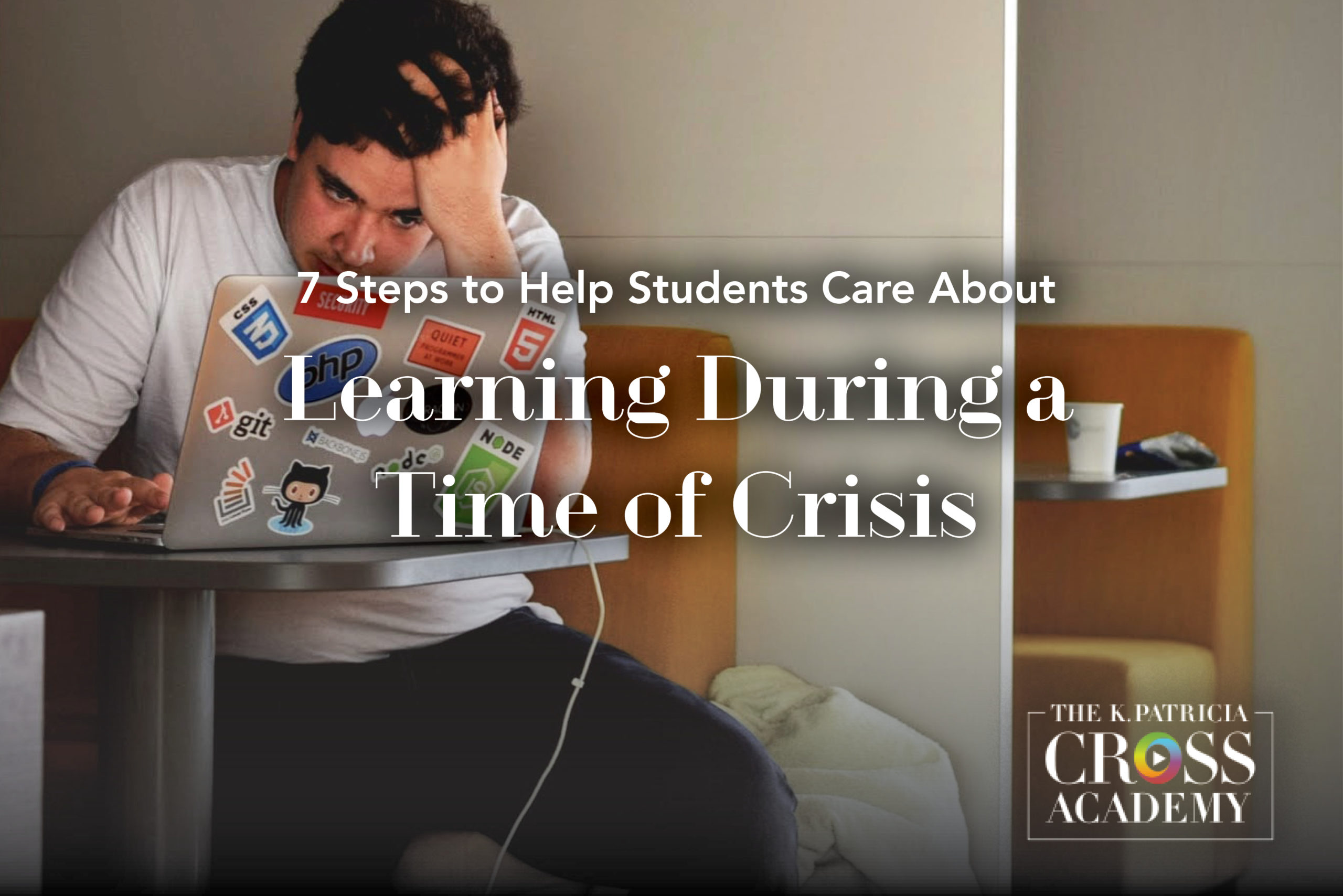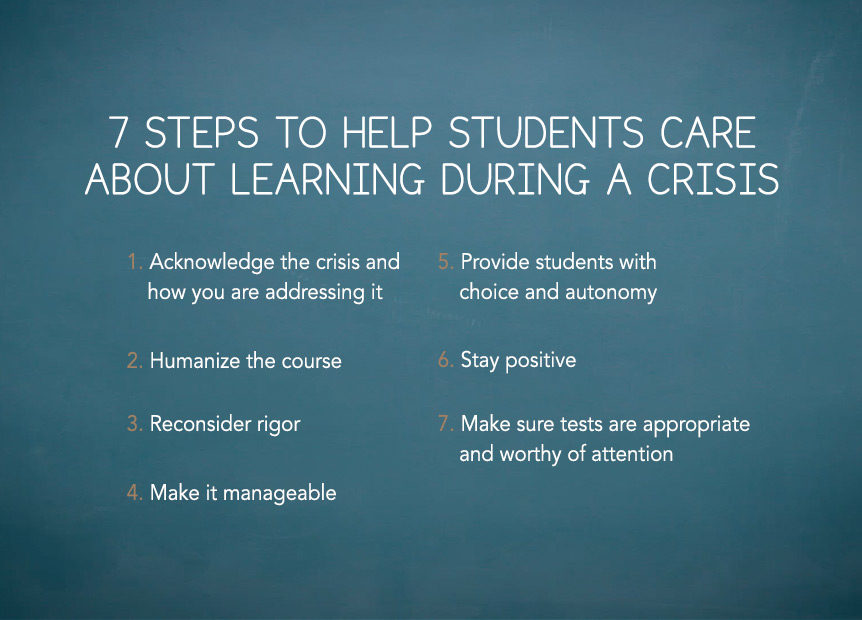
The COVID-19 pandemic and its surrounding political climate find us all in a time of crisis. Teachers and students alike are often caring for family members, friends, and themselves. That students are doing so while continuing their studies demonstrates that they do care, and they likely care deeply, for the people in their lives. But with the distractions brought about during this time of crisis, it can be a challenge for them to focus their care additionally on their studies.
As educators, we know there is a strong relationship between caring about learning and quality of learning. As Fink argues, “When students care about something, they then have the energy they need for learning more about it and making it a part of their lives. Without the energy for learning, nothing significant happens” (2013, p. 360). It seems simple common sense that students who really care about what they are learning will invest the time and effort required to learn it well and remember it longer. So how do we help students focus their care on learning, during a crisis, during an age of significant distraction?

What Does Caring Mean During a Crisis?
When we care about something, we have acquired an affective disposition toward it that combines concern and perhaps even affection: we value it, appreciate it, and anticipate opportunities to encounter it. “Caring” in education refers to the degree to which students are interested in, or have feelings about, various aspects of their learning, and it can apply to an array of foci that include topic-specific phenomena and ideas, human beings, and the process of learning itself. It means the focusing of consciousness and the narrowing of attention on learning
We often know when students care about their learning. If students care about a course, they will show up for it and will invest appropriate time and energy into the learning activities. If students care about their peers, they will listen actively when others speak and demonstrate compassion and empathy as they develop deeper understanding of another’s perspectives or experiences. If students care about the topic, they will ask pertinent questions and be sufficiently curious to go beyond the minimum class requirements. How does all this work when they simply don’t have the physical stamina, time, cognitive bandwidth, or emotional energy for the learning?

How Do We Get Students to Care about Learning during a Crisis?
Following are suggestions for promoting caring in college and university courses during a crisis:
1. Acknowledge the Crisis and How You are Addressing It. It will help students to care if they know that you care, too, and that you understand where they are coming from. Tell them how you have adapted the course or activities and explain how you hope they will adapt in turn.
2. Humanize the Course. Particularly if you are teaching online, make sure that you have a warm and inviting space for students. You also need to be there and show your personality. Helping students to make connections with you and with each other builds community in the class and can help students to care more about their own work. Being there and forming that community is likely the most essential element of caring in a time of crisis.
3. Reconsider Rigor. Rigor is important, but be sure that you aren’t focusing excessively on it. It’s important to balance rigor with being supportive of students and their learning during this time. Think through how you can provide a quality learning experience during these unique circumstances. Students are more likely to care if they believe that you aren’t out to prove how tough you and the course are, but instead are doing your best to ensure they learn.
4. Make it Manageable. Provide a clear structure and a clear schedule. Give students challenges that increase in difficulty incrementally. One reason that students fail to care is that they believe that they can’t or won’t be successful. One way to negate that is to give them small challenges so they can be successful in completing them and then build difficulty and complexity over time.
5. Stay Positive. There are many things to be negative about right now, but your course, content, and student learning aren’t part of that. You can help ensure that students care by staying positive about the learning. Consider using positive language, for example, talking about what they will gain from the course and how they will use it in the future or when we return to the “new normal.”
6. Provide Students with Choice and Autonomy. Provide students with choices so that they feel more invested. For example, you might let students choose which discussions to participate in, or you might give them options about how to participate, for example by sharing something they have created or by responding to a prompt with an essay.
7. Make sure Tasks are Relevant, Appropriate, and Worthy of Their Attention. Characteristics of a learning task can increase or decrease student caring. For example, consider the following questions: Is the task inherently interesting? Is it important to the students on a personal level? Can they make a connection between the task and their own lived experiences? Is there some novelty to it? Is the purpose clear? Is it important to them? Is it a creative activity? Is there enough time to successfully complete the task?
Cross Academy Techniques to Promote Caring
Consider the following techniques that promote caring and also provide students with ways to demonstrate caring about the topic or their learning:
Three-Minute Message: 3-Minute Messages are modeled on the Three-Minute Thesis (3MT) academic competition, in which students have three minutes to present a compelling argument and to support it with convincing details and examples.
View main video here: View Technique →
View online adaptation here:
Briefing Paper: In a Briefing Paper, students research a current problem of their choice, summarize the main issues, and present solutions to a specific audience.
View main video here: View Technique →
View online adaptation here:
What? So What? Now What? Journals: In What? So What? Now What? Journals, students reflect on their recent course-related activities as they respond to each prompt in a journal entry.
View main video here: View Technique →
View online adaptation here:
Sign Up for Our Newsletter
Enter your email below to receive information about new blog posts.
Suggested Citation
Barkley, E. F., & Major, C. H. (n.d.). 7 steps to help students care about learning during a time of crisis. CrossCurrents. https://kpcrossacademy.org/helping-students-care-in-a-time-of-crisis/

Engaged Teaching
A Handbook for College Faculty
Available now, Engaged Teaching: A Handbook for College Faculty provides college faculty with a dynamic model of what it means to be an engaged teacher and offers practical strategies and techniques for putting the model into practice.





